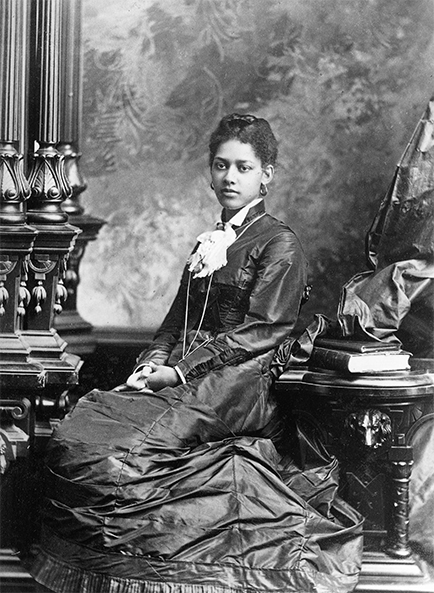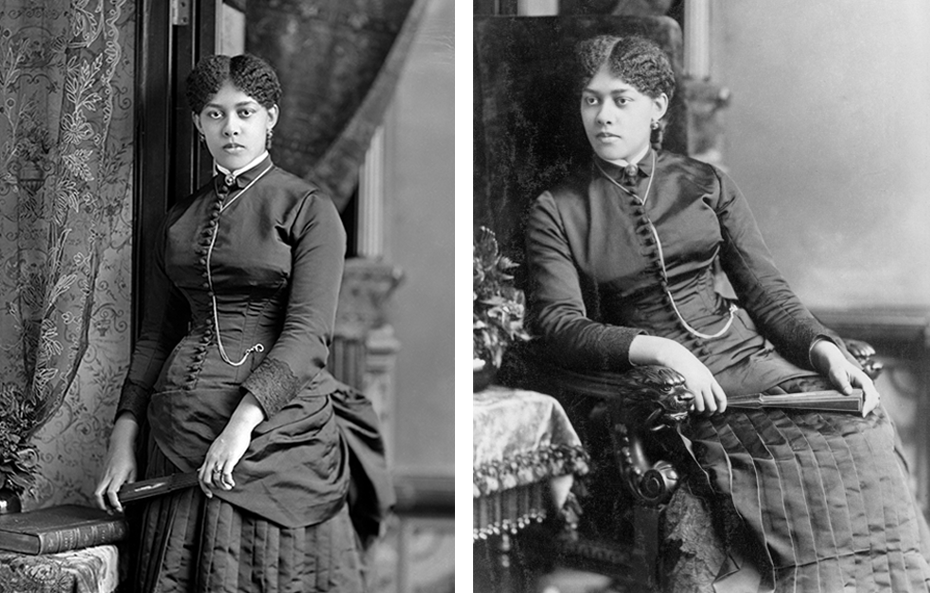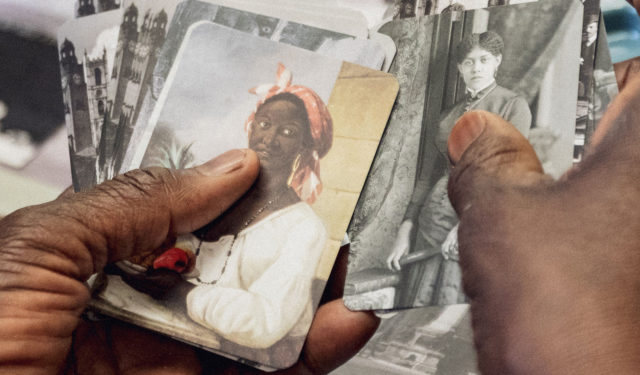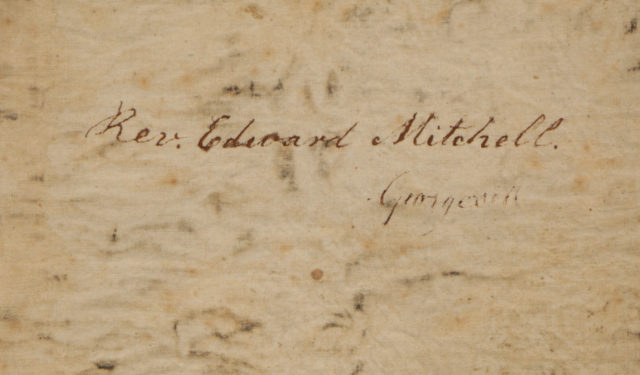Many questions come to mind
Meet Mary Ann Law Guilmartin, one of William Notman Studio’s portrait sitters, and discover her unbelievable story.
February 15, 2024
Many questions come to mind on looking at William Notman’s bewitching 1877 photograph of Mary Ann Law Guilmartin (1858-1917).
Who would believe that this epitome of elegance, then about 19, was born a slave? Her whole life was unbelievable—a broken fairy tale, early bits of which you might read on her face.
Who would believe that she was adopted by the Irish-American woman who had owned her, Frances Jane Mary Lloyd, and her Irish-Catholic husband, Lawrence James Guilmartin, a Savannah merchant of Confederate sympathies? He was a volunteer officer for the Confederacy in the U.S. Civil War (1861-1865), acted as a supplier to the Confederate army, and later supported the Democratic Party, which was certainly no champion of racial mixing or equal rights for Blacks.
To say that the childless Guilmartins defied convention in adopting Mary Ann, and treating her as their daughter, is a thundering understatement. What could explain their solicitude for this mixed-race girl, counted in the 1860 U.S. slave census as a nameless two-year-old “mulatto”? Was she a child Lawrence Guilmartin had fathered with the nameless 26-year-old Black woman who was recorded as his wife’s single other slave in 1860?
The St. Hyacinthe connection
Was it to shield the girl from the racist slings of Reconstruction and Jim Crow that they sent her to a girls’ school in St. Hyacinthe, Quebec, in the early 1870s? What possible link could there be between Savannah and St. Hyacinthe, where the Catalogue des Élèves du Séminaire de St. Hyacinthe depuis 1818, published in 1875, listed 11 white boys from Savannah, most of them enrolled in 1872? Two of the earlier students at this classical college were Lawrence Guilmartin’s nephews, sons of his sister Mary Ann Guilmartin and her slave-owning husband, Michael Prendergast. John Benedict Prendergast (1846-1898) enrolled in 1859 and later became a Jesuit priest; Felix Prendergast (1848-1885) was admitted in 1865.
What connection existed between the Guilmartins and the St. Hyacinthe family of silversmith Léandre Pierre Boivin and his Irish-Canadian wife, Marie Marguerite Amélie Caroline Whiteford, with whom Mary Ann boarded in the 1870s and formed lifelong friendships? Did the Guilmartins move to Quebec City in 1887 because life in Georgia had become uncomfortable for the white parents of a Black girl, or just to be near their daughter? From 1881 to 1887, Lawrence Guilmartin, co-owner of a coastal shipping line, served as president of the Hibernian Society of Savannah, and in 1886 was elected a director of the Merchants’ National Bank. Black daughter or not, he seemed well ensconced.
Mary Ann rejoined her parents in Georgia in about 1877. There were almost yearly trips to Quebec in the 1880s. The family seemed to favour the Iroquois House hotel in St. Hilaire as a home base for excursions. Newspaper accounts place them there in 1883, 1884, 1886, and 1887. In 1885, Mary Ann again sat for Notman in Montreal.
In June 1887, all three holidayed at the Huestis House in Saratoga, New York (Quebec Premier Honoré Mercier was a fellow guest), before moving on to the Iroquois House in July and the St. Lawrence Hall in Montreal in early September. It appears that Lawrence Guilmartin had said goodbye to Savannah. He moved to Quebec City that year and soon joined the consular corps, acting as Spanish consul pro tem in 1890, and Chilean consul from 1891.
Marriage and family
In Quebec City, on September 7, 1887, Mary Ann married Onésiphore Ernest Talbot (1854-1934). Talbot served as the Liberal Member of Parliament for Bellechasse County under Prime Minister Wilfrid Laurier from 1896 to 1911. He was also lieutenant-colonel of the 17th Regiment of Infantry in Lévis, and later a director of Canadian National Railways. What was Mary Ann’s status as the wife of an MP? Was she accepted or shunned, did she accompany her husband on election canvassing? Did he show her off or hide her away? Did she take part in social functions with other parliamentary wives? Was she sometimes mistaken for “the help”?
Who did her hair? Not all white hairdressers could handle Black curls. There were two well-regarded Black barber-hairdressers in Quebec City in her day: William Henry Medley, an African-American who died in 1889, and John Williams, a native Quebecer, both married to white women. Did she know them? Williams, son of a Black Jamaican and an Irish mother, twice married women of Irish descent, was a member, like Mary Ann, of St. Patrick’s Church, and plied his trade in town on St. Louis Street until 1913. “Private parlor for Ladies and Children’s Hair Cutting,” he advertised.
In 1888, Mary Ann had a son, Lawrence Ernest Talbot. Her marriage ended in a messy breakup a decade later. She left her home in Saint-Charles-de-Bellechasse and moved into her parents’ home at 174 Grande Allée in Quebec City, where she lived until she died. Neither she nor her husband had any other children. Her father died in Quebec City in 1902, her mother in 1906. Mary Ann was 59 when she died on Christmas Day in 1917. Her son died two months later, at age 29, on March 1, 1918. So ended the Guilmartin venture in Quebec.
Legacy
The Guilmartin name, however, lived on in a curious way, harking back to Mary Ann’s days in St. Hyacinthe. In 1876, her friend Marie-Anne Caroline Antoinette Boivin, the silversmith’s daughter, married Louis Édouard Morin of Longueuil. He was present at Lawrence Guilmartin’s funeral with his son. The son, christened Laurent Gustave Honoré Morin in 1879, signed his name Lawrence Guilmartin Morin at the funeral. Why was that? In 1903, he was married under the name Laurent Gilmartin Morin.
Laurent or Lawrence Guilmartin Morin’s godparents were his uncle, Joseph Boivin, and “Françoise Jeanne Marie Guilmartin,” Mary Ann’s mother. Joseph Boivin also attended Lawrence Guilmartin’s funeral. He too had risen in the world. From acting as private secretary to Premier Honoré Mercier, who had practised law in St. Hyacinthe, he had been named Deputy Provincial Secretary in 1890. This was the gilt-edged world in which Mary Ann moved, close to the seat of power. She and her husband had presented a wedding gift to Mercier’s daughter Elisa, in 1888, as had her parents.
Politics of the time
Did she pay attention to the world beyond the glitter? In 1911, for instance, the year her ex-husband lost his seat and the Laurier government collapsed, the federal cabinet closed the door to Black immigrants on August 12 with Order-in-Council 1911-1324: “For a period of one year from and after the date hereof the landing in Canada shall be and the same is prohibited of any immigrants belonging to the Negro race, which race is deemed unsuitable to the climate and requirements of Canada.” Did Mary Ann feel unsuitable—or affronted? Two months later, on October 15, OC 1911-2378 repealed OC 1911-1324. “His excellency in Council is pleased to Order that the Order in Council of the 12th August, 1911, prohibiting, for a period of one year, the landing in Canada, of any immigrant belonging to the Negro race, shall be and the same is hereby cancelled, said Order in Council having been inadvertently passed in the absence of the Minister of the Interior.”
Whatever the pretext for repeal, the reality was that Black women from the French Caribbean colony of Guadeloupe, hired to serve as domestics in Quebec for $5 a day, were pouring into the province, in a scheme hatched by Quebec-born Joseph Misaël Authier. From 1908, he had been U.S. consul at Guadeloupe and, before that, U.S. consul in St. Hyacinthe.
A total of about 220 female domestics were recruited between 1910 and 1925, all but a handful in 1911. That year the cry of “Slavery!” went up. Several employers were accused of passing their servants around without their consent and, before they would let them go, demanding $80 from them for the cost of bringing them to Canada. “More than 75 of these women have applied to the French consulate or to the Union Nationale Française to be returned to Guadeloupe,” the newspaper La Presse reported at the end of December.
Was Mary Ann any less concerned about other Blacks than her white mother? Not likely. In her will of 1905, Frances Guilmartin, converted former slave-owner, left $25,000 to St. Joseph’s Seminary in Baltimore, Md., “to be applied to the education, in said Saint Joseph Seminary or College, of colored youths for the priesthood.” After clearing some legal hurdles, Mary Ann, the ex-slave who needed no converting, turned over the $25,000 to the seminary in 1910. The seminary, now located in Washington, D.C., still serves African-Americans.
Further readings
Anbinder, Tyler. “Irish Origins and the Shaping of Immigrant Life in Savannah on the Eve of the Civil War.” Journal of American Ethnic History 35, no. 1 (Fall 2015): 5-37, especially 26-27.
Choquette, C.P. Histoire de la Ville de Saint-Hyacinthe. St. Hyacinthe: Richer et fils, 1930.
Derome, Robert. Personal Website. https://rd.uqam.ca/Delezenne/RegimeAnglais.html#Retraite
“Father John B. Prendergast.” Woodstock Letters 30, no. 3 (1901): 372-396.
Sheehy, Barry, Cindy Wallace and Vaughnette Goode-Walker. Savannah, Immortal City, Vol. 1, Civil War Savannah. Austin, TX: Emerald Book Co., 2011, 243.






